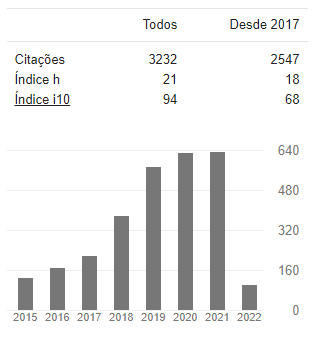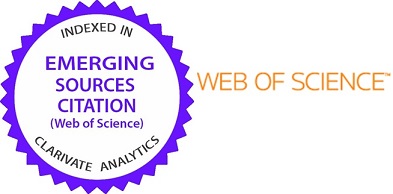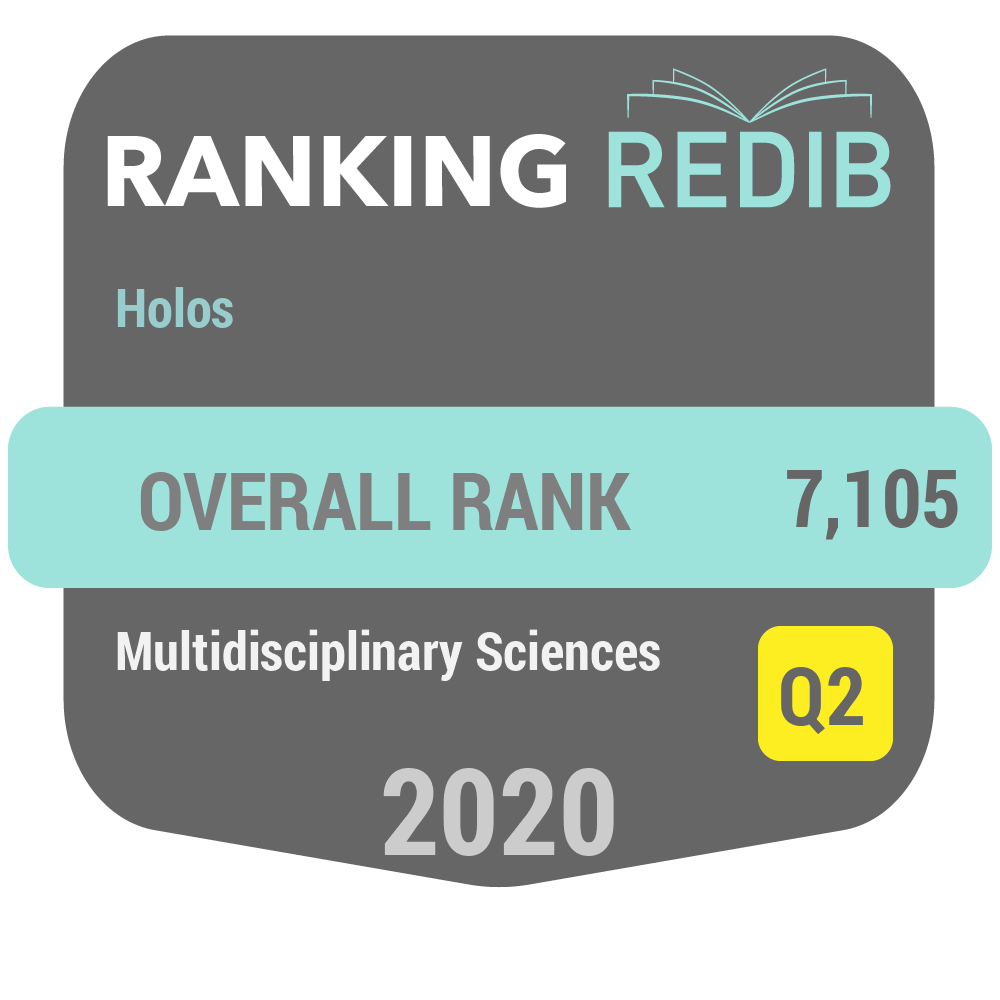CONCENTRAÇÃO DE METAIS EM SEDIMENTOS DA LAGOA DO PARQUE METROPOLITANO DE PITUAÇU, SALVADOR, BAHIA, BRASIL
DOI:
https://doi.org/10.15628/holos.2017.4502Palavras-chave:
Lagos, Contaminação antrópica, Efluente, ICP OESResumo
A lagoa de Pituaçu está inserida no Parque Metropolitano de Pituaçu (PMP). Esta recebe efluentes domésticos e pluviais e encontra-se em um processo acelerado de degradação ambiental. O presente trabalho teve como objetivo determinar a concentração de metais pesados (Al, Cu, Fe, Mn, V) em sedimentos superficiais da lagoa do Parque Metropolitano de Pituaçu, Salvador, Bahia, Brasil. Foram definidos 7 pontos amostrais. A determinação de metais (Al, Cu, Fe, Mn e V) foi realizada utilizando a técnica da espectrometria de emissão óptica com plasma indutivamente acoplado (ICP OES). A faixa de concentrações encontradas para os metais foram: Al (3.618-27.210 mg kg-1); Fe (11.968-122.030 mg kg-1); Mn (44,00-481,50 mg kg-1); V (25,00-111,50 mg kg-1) e Cu (4,05-25,50 mg kg-1). A ordem de concentração nos diversos pontos foi Fe>Al>Mn>V>Cu ou Fe>Al>Mn=V>Cu, com as maiores e as menores concentrações de todos os metais, encontradas nos pontos P1 e P3, respectivamente. Houve variações espaciais nas concentrações dos metais, com maiores concentrações nos pontos amostrais próximos de atividades antrópicas (efluentes e atividade agrícola). Esse estudo reporta níveis relativamente altos, especialmente para o V, indicando possíveis necessidades de ampliar ações de preservação ou monitoramento ambiental para evitar a acumulação desses metais em níveis tóxicos para a água e para o sedimento.
Downloads
Referências
ABUDUWAILI, J., ZHANG, Z. Y., & JIANG, F. Q. (2015). Assessment of the distribution, sources and potential ecological risk of heavy metals in the dry surface sediment of Aibi lake in northwest China. PLOS ONE, 17(3), 1-16.
Al-Musharafi, S. K., Mahmoud, I. Y., & Al-Bahry, S. N. (2014). Environmental Hazards and Pollution from Liquid Waste Lagoons. 5th International Conference on Environmental Science and Technology, 69, 1-5.
Calvert, S. E., & Pedersen, T. F. (1996). Sedimentary geochemistry of manganese: implications for the environment of formation of manganiferous black shales. Economic Geology, 91(1), 36–47.
Couto, V. C. (2011). Análise Geoambiental da Bacia Hidrográfica do Rio Coxipó em Cuiabá/MT (1988, 2000 e 2010), Três Lagoas, 2011. Dissertação do Programa de Pós-graduação de Geografia, Três Lagoas: Universidade Federal de Mato Grosso do Sul.
Dobrowolski, R., Adamczyk, A., & Otto, M. (2013) Determination of vanadium in soils and sediments by the slurry sampling graphite furnace atomic absorption spectrometry using permanent modifiers. Talanta, 113, 19-25.
Dural, M., Göksu, M. Z., & Özak, A. A. (2007). Investigation of heavy levels in economically important fish species captured from the Tusla lagoon. Food Chemistry, 102(1), 415-421.
Fidan, A. F., Cigerci, I. H., Konuk, M., Küçükkurt, I., Aslan, R., & Dündar, Y. (2008). Determination of some heavy metal levels and oxidative status in Carassius carassius L., 1758 from Eber Lake. Environmental Monitoring and Assessment, 147(1-3), 35-41.
Franz, C., Makeschin, F., Weib, H., & Lorz, C. (2014). Sediments in urban river basins: Identification of sediment sources within the Lago Paranoá catchment, Brasilia DF, Brazil–using thefingerprint approach. Science of the Total Environment, 466-467(1), 513-523.
González, E., Ahumada, R., Medina, V., Neira, J., & González, U. (2004). Espectrofotometría de absorción atómica con tubo en la llama: aplicación en la determinación total de cadmio, plomo y zinc en aguas frescas, agua de mar y sedimentos marinos. Química Nova, 27(6), 873-877.
Hahladakis, J., Smaragdaki E., Vasilaki G., & Gidarakos E. (2013). Use of Sediment Quality Guidelines and pollution indicators for the assessment of heavy metal and PAH contamination in Greek surficial sea and lake sediments. Environmental Monitoring Assessment, 185(3), 2843-2853.
HU, Y., Qi, S., Wu, C., Ke, Y., Chen, J., Chen, W., & Gong, X. (2012). Preliminary assessment of heavy metal contamination in surface water and sediments from Honghu Lake, East Central China. Frontiers of Earth Science, 6(1), 39–47.
Kabata-Pendias, A., & Mukherjee, A. B. (2007). Trace Elements from Soil to Human. 1st. Springer-Verlag GmbH, Berlin, Heidelberg, New York.
KHADEMI, N. Riyahi-Bakhtiari, A., Sobhanardakani, S., Rezaie-Atagholipour, M., & Burger, J. (2015). Developing a bioindicator in the Northwestern Persian Gulf, Iran: trace elements in bird eggs and in coastal sediments. Archives of Environmental Contamination and Toxicology, 68(2), 274-282.
Khoshnood, Z., Mokhlesi, A., & Khoshnood, R. (2011). Effects of oil pollution on EURYGLOSSA ORIENTALIS and PSETTODES ERUMEI in the Persian Gulf. Romeno Journal of Biologia e Zoologia, 56(2), 201-209.
López, D. L., Gierlowski-Kordesch, E., & Hollenkamp, C. (2010). Geochemical Mobility and Bioavailability of Heavy Metals in a Lake Affected by Acid Mine Drainage: Lake Hope, Vinton County, Ohio. Water Air and Soil Pollution, 213(1), 27–45.
Ministry of Agriculture, Fisheries, Food [MAFF]. Code of good agricultural practice for the protection of water. MAFF Publications, London, 1998.
Maia, P. D., Boaventura, G. R., & Pires, A. C.B. (2006). Distribuição espacial de elementos-traço em sedimentos do lago Paranoá - DF, Brasil. Geochimica Brasiliensis, 20(2), 158-174.
Meucci, V., Laschi, S., Minunni, M., Pretti, C., Intorre, L., & Soldani, G. (2009). An optimized digestion method coupled to electrochemical sensor for the determination of Cd, Cu, Pb and Hg, in fish by square wave anodic stripping voltametry. Talanta, 77(3), 1143-1148.
Montanha, F. P., Astrauskas, J. P., Kirnew, M. D., Nagashima, J. C., & Pimpão, C. T. (2011). Degradação de ambientes aquáticos por exposição a compostos químicos. Revista Científica Eletrônica de Medicina Veterinária, 10(17), 1-12.
Pompeo, M. L. M., Padial, P. R., Mariani, C. F., Cardoso-Silva, S., Moschini-Carlos, V., Silva, D. C. V. R. P., Paiva, T. C. B., & Brandimarte, A. L. (2013). Biodisponibilidade de metais no sedimento de um reservatório tropical urbano (reservatório Guarapiranga – São Paulo (SP), Brasil): há toxicidade potencial e heterogeneidade espacial? Geochimica Brasiliensis, 27(2), 104-119.
Porto, M. F. A; & Porto, R. L. L. (2008). Gestão de bacias hidrográficas. Estudos Avançados, 22(63), 43-60.
Sabino, C. V. S., Kastner, G. F., & Amaral, A. M. (2004). Estudo da biodisponibilidade de metais nos sedimentos da lagoa da Pampulha. Química Nova, 27(2), 231-235.
SANTANA, M. S. (2003). Experimento de Produção Primária no Reservatório de Pituaçu, Salvador, 2003. Monografia do Curso de Ciências Biológicas, Salvador: Universidade Federal da Bahia.
Schneider, L. Maher, W., Potts, J., Gruber, B., Batley, G., Taylor, A., Chariton, A., Krikowa, F., Zawadzki, A., & Heijnis, H. (2014). Recent history of sediment metal contamination in Lake Macquarie, Australia, and an assessment of ash handling procedure effectiveness in mitigating metal contamination from coal-fired power stations. Science of the Total Environment, 490, 659-670.
SCHRIKS, M., Heringa, M. B., Van der Kooi, M. M., Voogt, P., & Van Wezel, A. P. (2010). Toxicological relevance of emerging contaminants for drinking water quality. Water Research, 44(2), 461-76.
Secretaria do Meio Ambiente - Bahia [SEMA]. Disponível em: https://www2.meioambiente.ba.gov.br.
Sheela, A. M., Letha, J., Joseph, S., & Thomas, J. (2012). Assessment of heavy metal contamination in coastal lake sediments associated with urbanization: Southern Kerala, India. Lakes & Reservoirs: Research and Management, 17(2), 97-112.
Silva, E. Viana, Z. C. V., Souza, N. F. A., Korn, M. G. A., & Santos, V. L. C. S. (2016). Assessment of essential elements and chemical contaminants in thirteen fish species from the Bay Aratu, Bahia, Brasil. Brazilian Journal of Biology, 76(3), 871-877.
Souza, V. L. B., Lima, V. L., Hazin, C. A., Fonseca, C. K. L., & Santos, S. O. (2015). Biodisponibilidade de metais-traço em sedimentos: uma revisão. Brazilian Journal of Radiation Sciences, 3(1ª), 1-13.
Tavares, G. A., Ferreira, J. R., & Oliveira, C. R. (2003). Histórico da presença de metais pesados (Hg, Cu, Mn, Cr e Ni) na lagoa Rio das Pedras, Bacia do Rio Moji-Guaçu - SP, Brasil. Holos Environment, 3(2), 74-84.
Tylmann, W., ?ysek, K., Kinder, M., & Pempkowiak, J. (2011). Regional pattern of heavy metal content in Lake sediments in Northern Poland. Water Air and Soil Pollution, 216(1-4), 217-228.
Tucci, C. E. M. (1997). Hidrologia: ciência e aplicação. 2.ed. Porto Alegre: ABRH/Editora da UFRGS, 1997.
United States Environmental Protection Agency [U.S. EPA]. (1998). Method 3051a - microwave assisted acid digestion of sediments, sludges, soils, and oils. Disponível em: https://www.epa.gov/sites/production/files/2015-12/documents/3051a.pdf.
United States Environmental Protection Agency [U.S. EPA]. (1997). Exposure Factors Handbook (1997 Final Report). U.S. Environmental Protection Agency, Washington, DC, EPA/600/P-95/002F a-c, 1997. Disponível em: https://www3.epa.gov/airtoxics/cancer_guidelines_final_3-25-05.pdf.
Vrhovnik, P., S?muc, N. R., Dolenec, T., Serafimovski, T., & Dolenec, M. (2013). An evaluation of trace metal distribution and environmental risk in sediments from the Lake Kalimanci (FYR Macedonia). Environmental Earth Sciences, 70(2), 761-775.
Weiping, L., Zhang, W. B., & Yu, J. P. (2015). Distribution features and ecological risk assessment of heavy metals in superficial sedments of Hulun Lake. Journal of Applied Sciences, 15(4), 682-688.
Yang, Z., Li, G. & Wang, D. (2005). The assessment of heavy metals of Baiyang lake sediment and its potential ecological risk. Agriculture Environmental Science, 24, 945-951.
Yao, S., & Xue, B. (2014). Heavy metal records in the sediments of Nanyihu Lake, China: influencing factors and source identification. Journal of Paleolimnology, 51, 15-27.









































